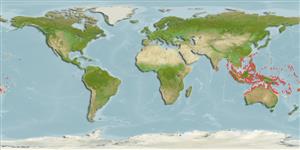Klassifizierung / Names
Namen | Synonyme | Catalog of Fishes(Gattung, Arten) | ITIS | CoL | WoRMS | Cloffa
Environment: milieu / climate zone / depth range / distribution range
Ökologie
seewasser riff-verbunden; tiefenbereich 1 - 20 m (Ref. 90102). Tropical; 27°N - 27°S, 28°E - 133°W (Ref. 74933)
Indo-Pacific: known from the Red Sea, Indian Ocean (except the Seychelles, Chagos Archipelago, Cargados Carajos, Mauritius and Rodrigues), north to Japan and south to Australia; throughout the West Pacific to the Tonga Islands, Samoa, Phoenix and Marshall Islands.
Size / Gewicht / Alter
Maturity: Lm ? range ? - ? cm
Max length : 11.2 cm TL Männchen/unbestimmt; (Ref. 90102)
Kurzbeschreibung
Morphologie | Morphometrie
Rückenflossenstacheln (insgesamt): 8; Rückenflossenweichstrahlen (insgesamt): 9; Afterflossenstacheln 2; Afterflossenweichstrahlen: 8.
Common in reef flats and shallow lagoons, but hiding by day within Acropora thickets and other corals, as well as in holes and crevices and emerging at night to forage on free-swimming invertebrates (Ref. 1602). Also found in sheltered seaward slopes in 1-20 m (Ref 90102). Feeds on small fishes and benthic invertebrates (e.g. shrimps - alpheids and penaieds; isopods, copepods, crab larvae, polychaete worms); relatively close to cover, within about 1-2 m (Ref. 11890).
Life cycle and mating behavior
Geschlechtsreife | Fortpflanzung | Ablaichen | Eier | Fecundity | Larven
Mouthbrooders (Ref. 240). Distinct pairing during courtship and spawning (Ref. 205).
Nakabo, T., 2002. Fishes of Japan with pictorial keys to the species, English edition I. Tokai University Press, Japan, pp v-866. (Ref. 41299)
IUCN Rote Liste Status (Ref. 130435)
Bedrohung für Menschen
Harmless
Nutzung durch Menschen
Mehr Information
ReferenzenAquakulturAquakultur ProfilZuchtlinienGenetikElectrophoresesVererbbarkeitKrankheitenVerarbeitungNutrientsMass conversion
PartnerBilderStamps, Coins Misc.LauteCiguateraGeschwindigkeitSchwimmstilKiemenoberflächeOtolithsGehirngrößeSehfähigkeit
Tools
Zusatzinformationen
Download XML
Internet Quellen
Estimates based on models
Preferred temperature (Ref.
123201): 25.7 - 29.3, mean 28.7 °C (based on 2182 cells).
Phylogenetic diversity index (Ref.
82804): PD
50 = 0.5020 [Uniqueness, from 0.5 = low to 2.0 = high].
Bayesian length-weight: a=0.01698 (0.01020 - 0.02828), b=2.97 (2.83 - 3.11), in cm total length, based on LWR estimates for this species & (Sub)family-body (Ref.
93245).
Trophic level (Ref.
69278): 3.3 ±0.2 se; based on diet studies.
Widerstandsfähigkeit (Ref.
120179): hoch, Verdopplung der Population dauert weniger als 15 Monate. (Preliminary K or Fecundity.).
Fishing Vulnerability (Ref.
59153): Low vulnerability (10 of 100).
Nutrients (Ref.
124155): Calcium = 138 [71, 220] mg/100g; Iron = 0.953 [0.557, 1.629] mg/100g; Protein = 18.6 [17.4, 19.8] %; Omega3 = 0.12 [0.07, 0.20] g/100g; Selenium = 28.6 [15.1, 55.2] μg/100g; VitaminA = 55.8 [16.2, 190.5] μg/100g; Zinc = 1.69 [1.11, 2.49] mg/100g (wet weight);
